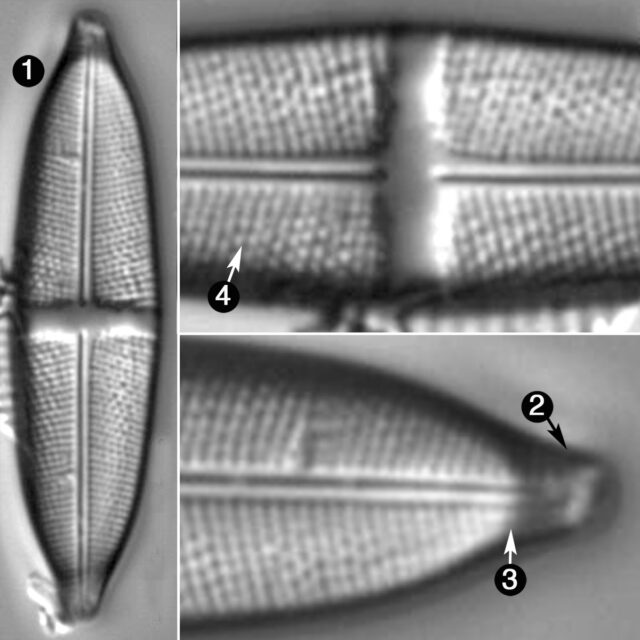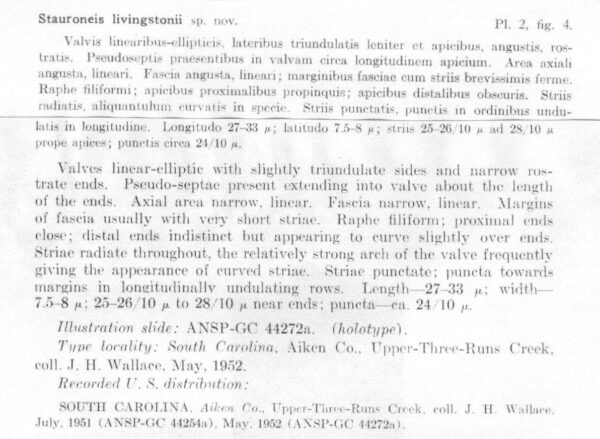Stauroneis livingstonii
-
Category
-
Length Range28-38 µm
-
Width Range6.6-8.6 µm
-
Striae in 10 µm22-28
-
Reported AsStauroneis smithii var. incisa (Siver et al. 2005)
-
ContributorLoren Bahls - Dec 2011
-
ReviewerMarina Potapova - Mar 2012
Identification
Description
Valves are linear-elliptic with subtly triundulate sides and short, narrow rostrate apices. A pseudoseptum is present at each apex. The axial area is very narrow and linear. A narrow, rectangular stauros is variable across specimens; it is slightly expanded or constricted near the valve margins. Short striae may be present within the stauros at the margins. The raphe is filiform. Proximal raphe ends are straight and weakly expanded. Striae are radiate. Areolae are variably spaced and number 22-28 in 10 µm.
Autecology
Stauroneis livingstonii is widespread in the Northern Rockies in small lakes and fens. The pH of these waters ranges from 6.0 to 8.1 and specific conductance ranges from 10 to 67 µS/cm. Reimer (1961) described this species from material collected in Three Runs Creek, a small dystrophic tributary of the Savannah River in South Carolina. Patrick & Reimer (1966) report it only from the type locality. Since then Camburn and Charles (2000) have reported it from lakes in the Adirondack Mountains and Siver et al. (2005) reported it (as Stauroneis smithii var. incisa) from seven neutral to slightly acidic ponds on Cape Cod.
-
Size Range, µm3
-
Motility
-
Attachment
-
Habitat
-
Colony
-
Waterbody
-
Distribution
- Learn more about this
Original Description
Valves linear-elliptic with slightly triundulate sides and narrow rostrate ends. Pseudo-septae present extending into valve about the length of the ends. Axial area narrow, linear. Fascia narrow, linear. Margins of fascia usually with very short striae. Raphe filiform; proximal ends close; distal ends indistinct but appearing to curve slightly over ends. Striae radiate throughout, the relatively strong arch of the valve frequently giving the appearance of curved striae. Striae punctate; puncta towards margins in longitudinally undulating rows. Length 27-33 µm; width 7.5-8 µm; 25-26/10 µm to 28/10 µm near ends; puncta ca. 24/10 µm.
-
AuthorReimer 1961
-
Length Range27-33 µm
-
Width7.5-8 µm
-
Striae in 10µm25-26 (middle) to 28 (ends)
Citations & Links
Citations
Links
-
Index Nominum Algarum
-
North American Diatom Ecological DatabaseNADED ID: 62010
Cite This Page
Bahls, L. (2011). Stauroneis livingstonii. In Diatoms of North America. Retrieved April 24, 2024, from https://diatoms.org/species/stauroneis_livingstonii
Responses
The 15 response plots show an environmental variable (x axis) against the relative abundance (y axis) of Stauroneis livingstonii from all the stream reaches where it was present. Note that the relative abundance scale is the same on each plot. Explanation of each environmental variable and units are as follows:
ELEVATION = stream reach elevation (meters)
STRAHLER = distribution plot of the Strahler Stream Order
SLOPE = stream reach gradient (degrees)
W1_HALL = an index that is a measure of streamside (riparian) human activity that ranges from 0 - 10, with a value of 0 indicating of minimal disturbance to a value of 10 indicating severe disturbance.
PHSTVL = pH measured in a sealed syringe sample (pH units)
log_COND = log concentration of specific conductivity (µS/cm)
log_PTL = log concentration of total phosphorus (µg/L)
log_NO3 = log concentration of nitrate (µeq/L)
log_DOC = log concentration of dissolved organic carbon (mg/L)
log_SIO2 = log concentration of silicon (mg/L)
log_NA = log concentration of sodium (µeq/L)
log_HCO3 = log concentration of the bicarbonate ion (µeq/L)
EMBED = percent of the stream substrate that is embedded by sand and fine sediment
log_TURBIDITY = log of turbidity, a measure of cloudiness of water, in nephelometric turbidity units (NTU).
DISTOT = an index of total human disturbance in the watershed that ranges from 1 - 100, with a value of 0 indicating of minimal disturbance to a value of 100 indicating severe disturbance.

Stauroneis livingstonii
- Valves linear-elliptic, 6.6-8.6 µm wide
- Apices narrow, rostrate, with pseudosepta
- Striae radiate throughout
Valves are linear-elliptic, 6.6 to 8.6 µm wide. Apices are narrow, rostrate, and with pseudosepta. Striae are radiate throughout.
 Diatoms of North America
Diatoms of North America







